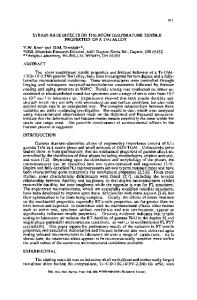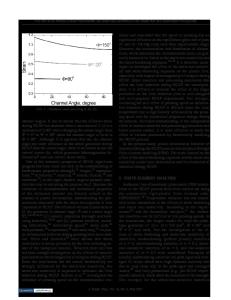Effects of strain rate and anisotropy on the tensile deformation properties of extruded AlZnMg alloys
- PDF / 2,105,650 Bytes
- 10 Pages / 612 x 792 pts (letter) Page_size
- 40 Downloads / 363 Views
I. INTRODUCTION
EXTRUDED profiles within the AlZnMg alloy series are used extensively in lightweight constructions, and new alloys with enhanced properties are being developed. Some “downstream” activities involve extruded sections that are shaped by stretch bending, in the solution heat-treated condition. Especially the element Mg, but also Zn and Cu in solid solution, lead to pronounced jerky flow and strain localization in these alloys.[1,2] Because of the extreme deformations involved in the extrusion process, a strong anisotropy remains in the extrudate. This anisotropy may influence subsequent forming operations[3] and the final properties.[4] This work is dedicated to a thorough investigation of the tensile properties of two such profiles: one with a fully recrystallized microstructure and one with a nonrecrystallized microstructure. The purpose is to achieve a better understanding of the deformation behavior upon pure deformation modes such as uniaxial tension and simple shear[5] in the solid-solution condition (W temper). The established knowledge provides a basis for further mathematical modeling. Serrated flow curves, also known as jerky flow, are due to dynamic strain aging (DSA). This phenomenon has been extensively studied over the past few decades.[6–11] It is attributed to the migration and locking of solute atoms to dislocations. For the deformation to continue, the dislocations must free themselves from the solute atoms. This causes an increase in the applied load, followed by a sudden collective motion of the dislocations accompanied by a drop in the applied load. Consequently, the stress vs strain curve has a serrated appearance. It is of great interest to study some of the consequences of DSA on mechanical behavior, such as negative strain-rate sensitivity (SRS) and strain localization. These phenomena are inter-related with the mechanical ALEXANDER FJELDLY, formerly Ph.D. Student, Department of Materials Technology and Electrochemistry, University of Science and Technology (NTNU), is Scientist, Division for Protection and Materiel, FFINorwegian Defence Research Establishment, 2027 Kjeller, Norway. HANS JØRGEN ROVEN, Professor, is with the Department of Materials Technology and Electrochemistry, NTNU, 7034 Trondheim, Norway. Manuscript submitted February 23, 1999. METALLURGICAL AND MATERIALS TRANSACTIONS A
anisotropy and may have significant impact on formability at room temperature. II. EXPERIMENTAL PROCEDURE A. AlZnMg Extruded Profiles Two commercial AlZnMg alloys were used in this study, with the chemical contents shown in Table I. The AA7108 alloy contains Zr, which forms recrystallization-preventing coherent dispersoids of the type Al3Zr. However, a thin (⬃100 m) recrystallized layer is usually seen toward the surface of the profiles. The 7030 alloy contains no Zr and, hence, a fully recrystallized structure, with a grain size of ⬃100 m, is developed during extrusion. In Figure 1, the microstructure is shown for the two alloys. Texture measurements have also been performed, and the orie
Data Loading...











